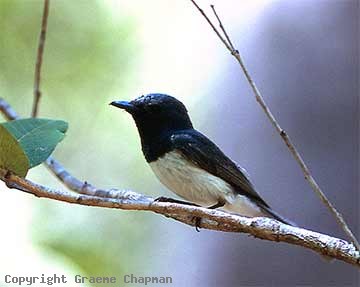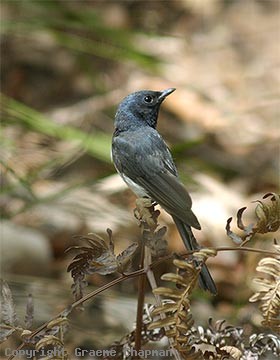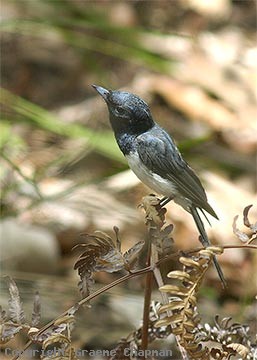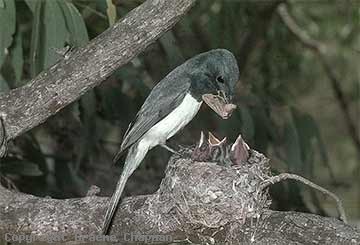
The Leaden Flycatcher is one of the most misidentified birds in eastern Australia, particularly in Queensland. Pic #365004 shows how a male Leaden can appear against the light and easily mistaken for a Satin Flycatcher, a species rarely seen in Queensland. One of the reasons they are so often misidentified undoubtedly stems from the illustrations in the field guides. Both painting and printing a blackish bird with a blue sheen is no easy task so most of the illustrations are less than ideal, but the main problem is that they fail to show correctly the main field mark for males - the shape of the breast band. They all get it wrong - only HANZAB shows it correctly. Look at my Satin Flycatcher pictures # 366213D and 366214D to see the two compared - the demarcation line is convex in one and concave in the other - chalk and cheese. Another useful clue for birds seen from below is that Leaden Flycatcher males have a grey undertail with clear white feather shafts - male Satin Flycatchers have a plain, dark brown undertail in which the feather shafts are not noticeable.
Females are another matter. Leaden females have a plain leaden-grey crown whereas Satins have a bluish sheen (see pics #s365215 and 366205) Some Satin females are a bit darker on the breast but this is a variable character. Immatures are virtually indistinguishable.
Another reason confusion occurs is that some people are unaware of the habitat preferences of the two species. Leadens occur in a wide variety of habitats including mangroves. Breeding Satin Flycatchers are cool country birds and except for far southern Victoria and Tasmania, are only found at higher elevations. Nevertheless, both species are seasonal migrants and can occur virtually anywhere in the brief periods they are on the move, usually in March and September. In southern latitudes Leadens usually arrive in September and the same territories are re-occupied year after year whereas in northern Australia they are regarded as sedentary. In the mountains near Canberra, I used to watch both Leaden and Satin Flycatchers breeding in adjoining territories, but this is not common.
In northern Australia, Leaden Flycatchers can also be confused with Broad-billed Flycatchers. Again, the field guides fail to show one of the most reliable field marks, the relative length of the tail feathers - of even length in Leadens and graduated in Broad-billed (see pics #s365206 and 367204 and 367208). Of course, moulting birds would be difficult to evaluate in this case.
The subspecies Myiagra rubecula yorki from coastal Queensland which has black lores ( pic #365214) was once classed as a separate species so we probably haven't heard the last word on this group of birds.
All three species, Leaden, Satin and Broad-billed and even the Restless Flycatcher have a range of whistling and harsh calls which are very similar. Leadens in particular exhibit a wide variation, both within individuals and from place to place, so identifying the species on calls is really a job for the expert. There are those who claim they can, but I admit to having difficulty. Listen on the sound pages.
Very dark glossy males that resemble Satin Flycatchers are occasionally seen in the Northern Territory. Rather than Satin Flycatchers, they are just as likely to be one of the many close relatives of the Leaden Flycatcher which are widespread in Melanesia. For those lucky enough to have a copy of Handbook of Birds of the World, have a look at plates 24 & 25 of Vol. 11.




